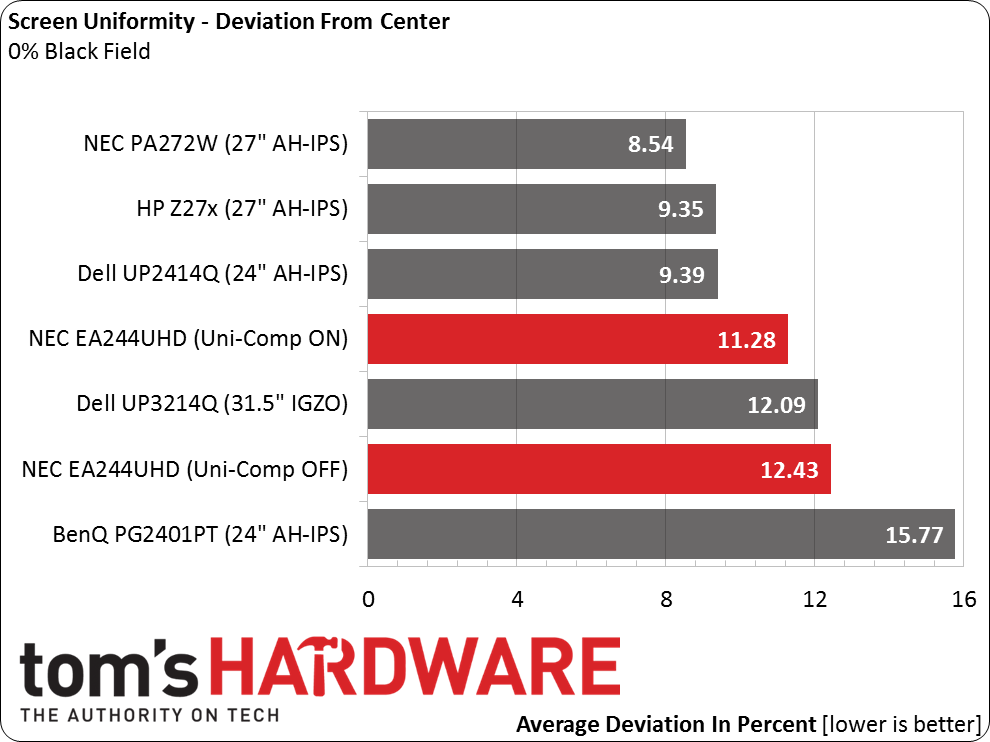NEC EA244UHD 24-Inch Ultra HD Monitor Review
Users seeking maximum pixel density need look no further than a 24-inch Ultra HD screen. We recently looked at Dell’s UP2414Q. Today we’re testing NEC’s EA244UHD. It’s part of the company's business-class line but offers much more than its stablemates.
Why you can trust Tom's Hardware
Results: Viewing Angles And Uniformity
To learn about how we measure screen uniformity, please click here.
Even though this is an AH-IPS display, its off-axis image quality is not quite as good as other IPS screens we’ve photographed. But it is a match for Dell's UP2414Q. Obviously, the horizontal red shift is endemic to this LG panel. Inside of 45 degrees, however, there is almost no change in color or luminance. And it’s still superior to the current crop of 28-inch Ultra HD TN-based panels.
Screen Uniformity: Luminance
The uniformity compensation doesn’t do much in the black field test. A 1.15-percent reduction is completely invisible. At least contrast isn’t affected too much. Our C6 shows hotspots in the upper-right and lower-left zones.
Here’s the white field measurement:
The white field result drops by more than half, although 5.77 percent is still a great result. In terms of brightness uniformity, you really don’t need uni-comp.
Screen Uniformity: Color
The biggest improvement comes in the color uniformity test. A result of 3.28 Delta E is just-visible. We could see the barest suggestion of green in the upper-right zone. When we turned the compensation on, it went away. You’d never notice such a slight aberration in actual content.
Our conclusion after testing several monitors with uniformity compensation is that modern LCD panels are improved to the point where the feature is unnecessary. Since it always reduces output and contrast, we leave it off. Only the most sensitive user would find a need for it.
Get Tom's Hardware's best news and in-depth reviews, straight to your inbox.
Pixel Response And Input Lag
Please click here to read up on our pixel response and input lag testing procedures.
The screen draw result matches Dell's UP2414Q which is what we'd expect. The EA244UHD also beats the two QHD IPS screens by a small margin. For those seeking the shortest scan times, TN is still the tech to beat.
Here are the lag results:
Input lag this high makes fast-paced gaming difficult. While you can run the monitor at 60Hz, there’s still too much delay to enjoy a first-person shooter. If fast reflexes are not required, the EA244UHD’s pixel density makes for stunning images in more mainstream titles.
Current page: Results: Viewing Angles And Uniformity
Prev Page Results: Color Gamut And Performance Next Page NEC's EA244UHD Offers Incredible Out-Of-Box Performance
Christian Eberle is a Contributing Editor for Tom's Hardware US. He's a veteran reviewer of A/V equipment, specializing in monitors. Christian began his obsession with tech when he built his first PC in 1991, a 286 running DOS 3.0 at a blazing 12MHz. In 2006, he undertook training from the Imaging Science Foundation in video calibration and testing and thus started a passion for precise imaging that persists to this day. He is also a professional musician with a degree from the New England Conservatory as a classical bassoonist which he used to good effect as a performer with the West Point Army Band from 1987 to 2013. He enjoys watching movies and listening to high-end audio in his custom-built home theater and can be seen riding trails near his home on a race-ready ICE VTX recumbent trike. Christian enjoys the endless summer in Florida where he lives with his wife and Chihuahua and plays with orchestras around the state.
-
milkod2001 @alidanReply
That's no telly, it's professional desktop monitor, could be 27 or 30'' but would probably cost another 1000 or more extra. -
vincent67 Agree with alidan, at this density, pixels are wasted: you don't see more as you need to scale everything up.Reply
And, knowing the hardware you need to drive this resolution,, I don't see any interest except for some niches.
You need at least 44'' to exploit 4K. -
ribald86 @vincent67Reply
UHD is 2560x1440/2560x1600 - not 4k. Even if it was 4k, I don't see how you can say it is wasted. -
Textfield The problem with these high-DPI screens is that support for these displays is lacking in many modern OS's. Yes, support is getting better, as with Windows 8.1 and its better UI scaling, but even with good support in the OS's UI, you're still at the mercy of the apps you use, and many are terrible when it comes to high DPI, with some even failing to work properly.Reply
Retina is only useful when your programs provide good support for it. Otherwise it's just an annoyance. As an owner of a Yoga 2 Pro (13" 3200x1800), I can speak to this. I normally run my laptop in an upscaled 1920x1080 just to keep compatability.





